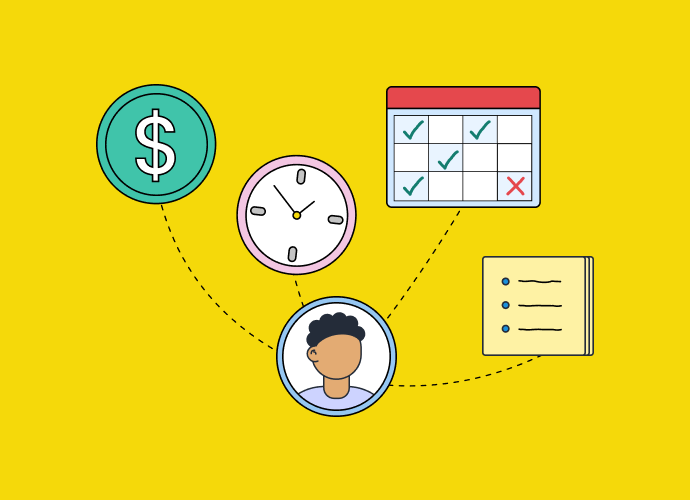The core purpose of a resource management plan is to set expectations. You must account for every task in a project—no matter how big or small—and determine what resources need to be secured to complete each task...
...which is why creating a concrete plan is one of (if not the) most important parts of the . Knowing what you need to carry out a project before it begins is the only reliable way to deliver it on time and within budget, without straining your team or falling short.
Follow the tips below to start creating an effective plan that’ll help you manage resources across your projects.
What is a resource management plan?
A resource management plan is a detailed proposal for allocating, managing, and tracking resources needed to complete a project.
The term “resources” in project management often refers to people (or, more accurately, people’s availability and skills), but it can also include materials, machinery, office space, finances, software and hardware.
In general, a resource management plan focuses on six main components:
- Project resource needs (including physical resources)
- Number of people needed and their capacity (e.g., weekly work hours)
- Selection criteria for people (e.g., skillset) and vendors (e.g., budget)
- Roles and responsibilities
- Available budget
- Success metrics and monitoring process
How accurately can managers plan for future human resources needs?
Project managers and resource managers may sometimes distinguish between a human resource management plan vs a physical resource plan. It’s usually possible to forecast how many people you’ll need in the future by using projected growth, future goals, turnover rates, or calculations.
If things change and new project needs present themselves, however, your project resource management plan will change too. It’s important to review and re-evaluate it constantly.
How to create an effective resource management plan (in 6 steps)
When you are trying to create a resource utilization plan, there are a few basic questions you absolutely must answer:
- What do I need?
- What do I have?
- How do I get what I don’t have?
- How do I organize it all?
And the way to answer these questions is to... ask yourself some more questions!, and then narrow down the answers. For example:
- What are the physical resources needed for each task?
- How much of the physical resources will we need during the project?
- How many people do we need to employ for the project? What will be their work contract? (employees, freelancers, part-time, etc.)
- What are the skillsets we’re looking for, and who has which?
- Where will we acquire the right resources?
- When will each resource be needed?
- What are the costs we need to account for?
- How will we monitor resource allocation both in real time and also over time?
Let’s get into the specifics. Here are six steps to developing your resource management plan:
1. Ensure you’ve settled on the right requirements
The specific requirements of the project will inform your resource management plan. If (...when?) something changes, both your resource planning and your resource utilization might be affected—so you can try to avoid this as much as you can by ensuring the project is well thought out from the start.
For example: review the project timeline, deliverables, and the (e.g., waterfall or agile) you’ll be using. Build the work breakdown structure—including every task needed to complete deliverables and what it entails.

Also, it’ll be a massive help to flesh out roles and responsibilities early on for the people you know you’ll need. Here’s an example:
- Role: Lead Developer
- Responsibility: Design architecture and development framework
- Qualifications: Experienced team leader, JavaScript, JSON
2. Make a list of resources
Before you can allocate, manage, or release your resources, you need to know what they are. This is the time to ask yourself “What do I need?” and answer with a list.
We recommend using a resource breakdown structure (or RBS), which is a hierarchical representation of resource categories and types. It’s essentially a list of everything you need for a project that will cost you (or your business) money. To create the full project plan, you’ll need to combine the RBS with the work breakdown structure.
Start by listing what’s needed. You can categorize resources however it makes sense for your organization. For example, you might have three developers listed under technical resources, which is itself categorized under the people category:

Use any format that works for you and your team. It could be a spreadsheet or a collaborative design tool (e.g., a Miro or FigJam board). If you don’t have all the information yet, you can also add placeholders to fill in later.
Bonus tip: if you or your organization has had experience with similar projects in the past, don’t hesitate to look into them as well—both the planning phase and the eventual resources that were needed.
3. Coordinate with your team and gather information
Sync with all the team stakeholders involved in the project to gather information. This can help you:
- Assess whether your team has the capacity to take on the full workload
- Determine if you need to hire new employees or contractors
- Settle on the needed quantity of resources
- Review milestones, tools, and vendors, as your team may have specific ideas or experiences that can come in handy
- Dig into limitations. For instance, if you have people who only work 20 hours a week, can you assign overtime to them if needed? Are the people with the skillsets you need currently operating at full capacity? Take a close look at your teams’ schedules (including time off and parallel projects) to see if there’s anything that may cause a conflict.
...and then, incorporate all this information into your list.

4. Get buy-in from other stakeholders
This step will help you assess and list any project constraints... because to budget a project, you need the finance team’s help; to hire people, you need recruiters or the HR department to lead; IT will tell you about software and network requirements; your operations team can determine the locations, materials, or other elements you need.
Staying on budget is particularly important. Is the finance team open to a flexible project budget? How do you ask for new financial resources if the need arises? What reports do they need and when (especially if the project spans months or years)?
5. Align resources with the project
Once you know the resources you need, you can finally allocate them to specific tasks. Project scheduling also comes into play here, as you’ll need to assign specific resources across the entire project timeline. Make sure to set the right expectations by organizing tasks and dependencies (e.g., by ).
Dedicated resource management software like ����ɫ��Ƭ will make your life much easier, especially when it comes to your most important resource: people. You can view everyone’s availability and assigned tasks and monitor their progress over time. You can see your team’s upcoming time off at a glance to plan around it and get a visual indicator of when people are being overutilized.

6. Plan to procure resources
You should now have a firm idea of the resources you need—so it’s time to start gathering them. The first step is communicating your resource management plan to all project team members who will participate in the project.
It’s also the time to source contractors, vendors, and equipment, build contracts, set budgets, and determine any terms and conditions you’ll use. Put everything in one structured document, and you’ve got yourself a bonafide resource management plan.
The right resource management plan for the project
A good resource plan creates transparency and accountability for the entire project. You’re better equipped to monitor and manage resources over time and make sure you’re using them to the best of their abilities.
Just remember to keep a close eye on things, and don’t be afraid to fine-tune whenever needed. Happy planning!
<cta-box>
<image-color="yellow">
Resource planning made easier
Plan projects and schedule tasks with a single, live view of your team’s capacity and skills.
<cta-button></cta-button>
</cta-box>
<hr>
Before you go: did you want to learn more about Resource Management?
You’re in luck—we have some additional reading for you:
<sme-box>
&����;������-���DZ��ǰ�=′������Ƿ�”&����;
<sme-quotes>
- A very (very) comprehensive introduction to resource management
- A list of 10 effective resource management best practices
- An overview of the best resource management software (& how to choose the right tool)
- A summary of the resource management skills you’ll need as a resource manager
- The 10 headache-inducing challenges of resource management and how to overcome them
- Some excellent answers to why is resource management important? (from real people planners)
- A crash course in resource utilization, with two calculation methods to try
- A list of 5 resource management techniques you can use to keep your projects going
- A deeper look at the resource smoothing technique to stay on schedule
- An overview of the resource leveling technique to help you complete projects with your available resources
</sme-quotes>
</sme-box>






%201.png)





